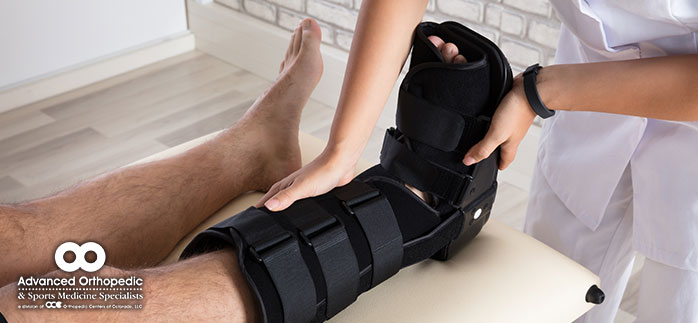There are numerous causes of ankle pain from arthritis to trauma, and ankle repair procedures vary widely according to the type of injury or illness. Learn when a sprain, strain or other injury is severe enough to require treatment or surgical solution. In Denver, ankle repair doctors treat the entire spectrum of injuries and illnesses that cause ankle pain.
Ankle sprains or tears
When the ligaments connecting your ankle bone to the rest of your foot and leg are stretched too far, the result is an ankle sprain. For most sprains, time, along with a regimen of rest, ice, compression and elevation (RICE) is enough to repair the damage. Some people also benefit from a wrap or brace to stabilize or immobilize the joint while the ligaments heal. Giving your ankle enough time to fully heal is essential. Repeat sprains can occur if the injury goes untreated or doesn’t heal properly, and more complex ankle repair may be needed.
If the ligaments are strained to the point of tearing, ankle repair may include longer immobilization or even surgery, as well as physical therapy. Surgery can be used to repair or replace the torn ligaments, depending on the severity of the tear.
Ankle fractures
A broken ankle can impact one or more of the three bones that make up the ankle, and ankle fractures often occur with ligament damage, especially when more than one of the ankle bones is broken. As with most fractured bones, the more severe the break, the more involved and time intensive the ankle repair.
Ankle fractures can occur from over rotating (“rolling”) or twisting the ankle, or from other trauma caused by sports collisions, falls, car accidents, etc. In addition to a physical exam, doctors use various imaging methods such as x-rays, MRIs and CT scans to determine the type and severity of an ankle fracture. If surgery is required to repair the ankle, a surgeon will reposition any bone fragments to realign your ankle bones. These pieces may then be held together with plates and/or screws so they can correctly heal.
Achilles tears or tendonitis
The Achilles is the largest of our tendons and connects the calf muscles to the heel bone. People who have repeatedly experienced tendonitis in the Achilles, which presents with inflammation and pain, can be more prone to tearing their Achilles tendon. Tendonitis can be treated with rest, ice, immobilization, physical therapy and non-steroidal anti-inflammatory drugs (NSAIDs), like Advil.
An Achilles tear is typically accompanied by a “pop,” and the pain can range from severe to none at all. Some people experience a sudden pain in the calf, others, pain in the heel. Most feel very unstable when attempting to walk after the Achilles ruptures.
Ankle repair for an Achilles tear involves surgery to reattach the tendon to the bone or tendon to tendon. Your Denver ankle repair specialist may want to order an MRI in addition to a physical exam to confirm a tear or the severity of any tendonitis.
Arthritis
Both rheumatoid arthritis and osteoarthritis can cause ankle pain due to inflammation and eventual destruction of the tissue (cartilage) between the ankle bones. Although the nature of the damage is different in each type of arthritis, in both cases, some patients respond well to non-surgical ankle treatments like rest, ice, steroid injections and NSAIDs. However, end-stage arthritis of the ankle may require surgery to resolve chronic pain issues.
Chronic Ankle Instability
People who have had multiple ankle sprains can develop chronic ankle instability, where the ankle frequently gives way on the outside of the foot. This can happen to anyone regardless of age and occurs in athletes and non-athletes alike. Symptoms include frequent swelling and pain, and overall lack of stability that often results in a turned ankle while standing, walking, running or competing.
Many treatments for this type of ankle repair are non-surgical and include patients wearing an ankle brace for support and protection during day-to-day activities; and physical therapy to build balance, strength and stability. Surgical ankle repair is typically considered if more conservative treatments are not effective, and the instability is significantly impacting a patient’s lifestyle.
Whether chronic ankle pain is disrupting your life, or a traumatic event causes damage to your ankle, ensure you take time for proper healing and ankle repair. Our experienced foot and ankle doctors, and our comprehensive team of physicians’ assistants, physical and occupational therapists and more are here to help you get moving again!










